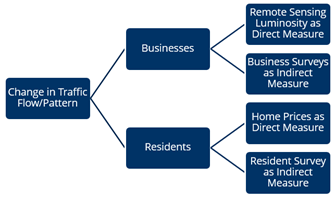This research examined the economic impact of reduced conflict intersection (RCI) design otherwise known as restricted crossing U-turn intersections. The analysis involved a multifaceted approach using remote sensing radiance data to analyze economic activity adjacent to RCI improvements, a business survey to assess business perceptions of RCIs, a residential real estate analysis, and resident survey.
The remote sensing analysis utilizing a multi-group interrupted time series analysis yielded mixed results with most models resulting in a null effect.
However, two locations were suggestive of a positive and significant effect on economic activity for development adjacent to the RCI compared to a control location.
However, analysis of two of the three industrial parks studied show evidence of decreased economic activity following the installation of the RCI.

Research Approach
The business survey indicated that businesses with a large number of customers and that are busiest later in the day are more likely to believe RCIs make their business easier to reach. Industrial users were less likely to agree that RCIs make their businesses easier to reach and more likely to indicate a safety concern around their facilities.
Analysis of residential real estate sale prices yielded mixed results and indicate that RCIs have potential to support home values but extended wait times at the U-Turn portion of an RCI intersection could have a negative effect. This assertion is supported by the residential survey results which show residents are willing to “pay" for safety with increased wait times but are decidedly more averse to additional time to turn left than an increase in total commute time. This difference in aversion to increased travel time indicates that residents value traffic flow; a result further supported by respondents increased willingness to make a trip for a single item if the road is not congested and make an impulse stop for a snack or coffee when traffic is light.
